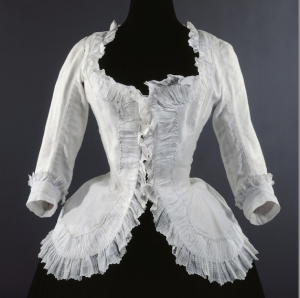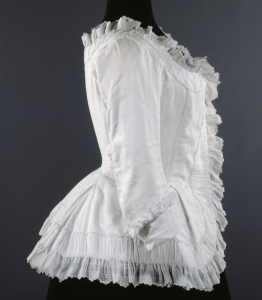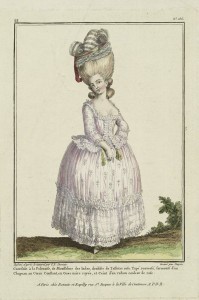So if you’re an 18th century costume geek, you’ve probably noticed the discussions floating around about what is a “real” polonaise. I’m excited to report that Brooke Welborn, the researcher who discovered that what many modern day historians were calling a polonaise was not the same thing as what eighteenth-century people defined as a polonaise, and I (who had been researching the very similar robe à la turque for a few years) decided to put our heads together and research and write an academic article on the topic. It’s been accepted by Dress, the journal of the Costume Society of America, and will come out this May. I plan to write a summary of our findings and post them here as we get closer to the publication date (as well as info on how to get the full article), but the in the meantime, here’s the two sentence summary — no news to those of you who’ve taken Brooke’s polonaise workshops through Burnley & Trowbridge, or been to my classes at Costume College, or read the various blogs mentioning our research:
In the eighteenth century, the “polonaise” was a term for a style of dress or jacket that was cut differently from the robe à l’anglaise: it had a cutaway front, with the bodice closed at the neckline and sloping away into an inverted V shape (incorrectly called “zone”); the robe/jacket front and back were cut without a waist seam, with inverted pleats opening up from the seams, like a man’s coat. The term “polonaise” was never applied to any dress worn with skirts looped up; these were called “retroussée” in French (e.g. robe à l’anglaise retroussée), with no specific equivalent term found in English (dresses were worn “back” or “up”).
So look for a longer summary in the next few months, as well as my research into that pesky term “zone,” which I would like to hereby banish from everyone’s vocabulary!
Of course, I’ve had to experiment with recreating this style — a few years back I made a proper robe à la polonaise, but didn’t blog it as the more information you put out there, the more likely you’re going to get scooped! I will, however, post some more information about this dress as I get that research summary posted.
Now, I’d like to make a jacket version of this style, specifically this polonaise style jacket from the Musée Galliera in Paris, which I love for its froofy trim:


I particularly love that if you look at the trim up close, you’ll see that it’s done in a windowpane cotton, while the jacket itself is in a solid:

I’ve decided to fill out the ensemble based on this 1780 fashion plate from the Gallerie des Modes:

Specifically, the plan is a solid white cotton voile for the jacket and petticoat, with trim in a windowpane cotton. The fashion plate’s dress is a sheer cotton lined in pink taffeta, an idea about which I started to get very excited, until I realized that I didn’t have any solid silk taffeta that I could use in my stash, I really shouldn’t go buying a bunch of silk taffeta given my current budget, and when I held up swatches under the sheer cotton the lining color didn’t show enough to make me love it as much as I did in the abstract. So, I’m hoping I can maybe wear a colored petticoat from another outfit under the skirt, and of course a kick ass silly hat!
Next post: draping and sewing the jacket!
This is going to look so lovely! There’s not enough windowpane in 18th century costuming.
I’ve been following what information you have dropped about robes à la Polonaise so far and I think I’ve gotten right what comes to the garment itself, but I’ve still obviously managed to mess terms in regards to robe à l’Anglaise. Thank you for giving the correct terms! I’m off to fix my blog now. 🙂
This is going to be gorgeous! I look forward to reading your research and theories about this style.